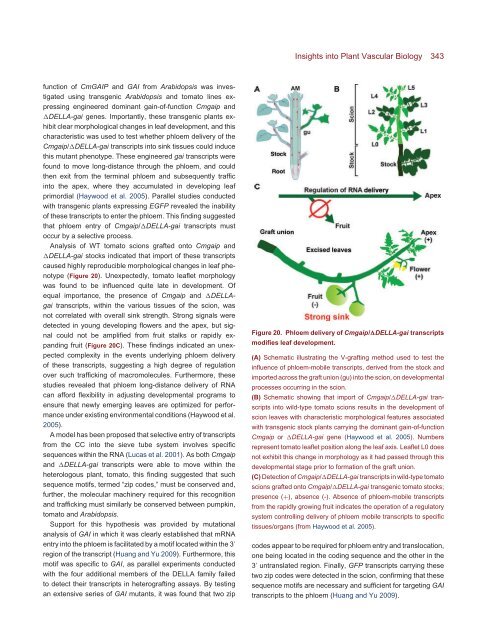The Plant Vascular System: Evolution, Development and FunctionsF
The Plant Vascular System: Evolution, Development and FunctionsF
The Plant Vascular System: Evolution, Development and FunctionsF
You also want an ePaper? Increase the reach of your titles
YUMPU automatically turns print PDFs into web optimized ePapers that Google loves.
function of CmGAIP <strong>and</strong> GAI from Arabidopsis was investigated<br />
using transgenic Arabidopsis <strong>and</strong> tomato lines expressing<br />
engineered dominant gain-of-function Cmgaip <strong>and</strong><br />
DELLA-gai genes. Importantly, these transgenic plants exhibit<br />
clear morphological changes in leaf development, <strong>and</strong> this<br />
characteristic was used to test whether phloem delivery of the<br />
Cmgaip/DELLA-gai transcripts into sink tissues could induce<br />
this mutant phenotype. <strong>The</strong>se engineered gai transcripts were<br />
found to move long-distance through the phloem, <strong>and</strong> could<br />
then exit from the terminal phloem <strong>and</strong> subsequently traffic<br />
into the apex, where they accumulated in developing leaf<br />
primordial (Haywood et al. 2005). Parallel studies conducted<br />
with transgenic plants expressing EGFP revealed the inability<br />
of these transcripts to enter the phloem. This finding suggested<br />
that phloem entry of Cmgaip/DELLA-gai transcripts must<br />
occur by a selective process.<br />
Analysis of WT tomato scions grafted onto Cmgaip <strong>and</strong><br />
DELLA-gai stocks indicated that import of these transcripts<br />
caused highly reproducible morphological changes in leaf phenotype<br />
(Figure 20). Unexpectedly, tomato leaflet morphology<br />
was found to be influenced quite late in development. Of<br />
equal importance, the presence of Cmgaip <strong>and</strong> DELLAgai<br />
transcripts, within the various tissues of the scion, was<br />
not correlated with overall sink strength. Strong signals were<br />
detected in young developing flowers <strong>and</strong> the apex, but signal<br />
could not be amplified from fruit stalks or rapidly exp<strong>and</strong>ing<br />
fruit (Figure 20C). <strong>The</strong>se findings indicated an unexpected<br />
complexity in the events underlying phloem delivery<br />
of these transcripts, suggesting a high degree of regulation<br />
over such trafficking of macromolecules. Furthermore, these<br />
studies revealed that phloem long-distance delivery of RNA<br />
can afford flexibility in adjusting developmental programs to<br />
ensure that newly emerging leaves are optimized for performance<br />
under existing environmental conditions (Haywood et al.<br />
2005).<br />
A model has been proposed that selective entry of transcripts<br />
from the CC into the sieve tube system involves specific<br />
sequences within the RNA (Lucas et al. 2001). As both Cmgaip<br />
<strong>and</strong> DELLA-gai transcripts were able to move within the<br />
heterologous plant, tomato, this finding suggested that such<br />
sequence motifs, termed “zip codes,” must be conserved <strong>and</strong>,<br />
further, the molecular machinery required for this recognition<br />
<strong>and</strong> trafficking must similarly be conserved between pumpkin,<br />
tomato <strong>and</strong> Arabidopsis.<br />
Support for this hypothesis was provided by mutational<br />
analysis of GAI in which it was clearly established that mRNA<br />
entry into the phloem is facilitated by a motif located within the 3 ′<br />
region of the transcript (Huang <strong>and</strong> Yu 2009). Furthermore, this<br />
motif was specific to GAI, as parallel experiments conducted<br />
with the four additional members of the DELLA family failed<br />
to detect their transcripts in heterografting assays. By testing<br />
an extensive series of GAI mutants, it was found that two zip<br />
Insights into <strong>Plant</strong> <strong>Vascular</strong> Biology 343<br />
Figure 20. Phloem delivery of Cmgaip/DELLA-gai transcripts<br />
modifies leaf development.<br />
(A) Schematic illustrating the V-grafting method used to test the<br />
influence of phloem-mobile transcripts, derived from the stock <strong>and</strong><br />
imported across the graft union (gu) into the scion, on developmental<br />
processes occurring in the scion.<br />
(B) Schematic showing that import of Cmgaip/DELLA-gai transcripts<br />
into wild-type tomato scions results in the development of<br />
scion leaves with characteristic morphological features associated<br />
with transgenic stock plants carrying the dominant gain-of-function<br />
Cmgaip or DELLA-gai gene (Haywood et al. 2005). Numbers<br />
represent tomato leaflet position along the leaf axis. Leaflet L0 does<br />
not exhibit this change in morphology as it had passed through this<br />
developmental stage prior to formation of the graft union.<br />
(C) Detection of Cmgaip/DELLA-gai transcripts in wild-type tomato<br />
scions grafted onto Cmgaip/DELLA-gai transgenic tomato stocks;<br />
presence (+), absence (-). Absence of phloem-mobile transcripts<br />
from the rapidly growing fruit indicates the operation of a regulatory<br />
system controlling delivery of phloem mobile transcripts to specific<br />
tissues/organs (from Haywood et al. 2005).<br />
codes appear to be required for phloem entry <strong>and</strong> translocation,<br />
one being located in the coding sequence <strong>and</strong> the other in the<br />
3 ′ untranslated region. Finally, GFP transcripts carrying these<br />
two zip codes were detected in the scion, confirming that these<br />
sequence motifs are necessary <strong>and</strong> sufficient for targeting GAI<br />
transcripts to the phloem (Huang <strong>and</strong> Yu 2009).
















